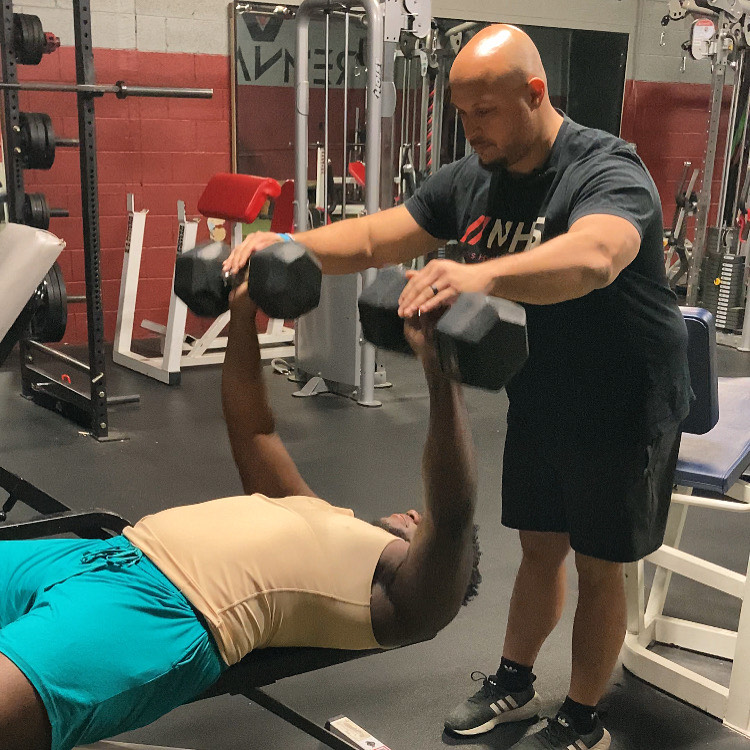
Hello there, I am Coach Matt Reed. I have been a strength & conditioning coach for the past 10 years and have trained countless college athletes across all divisions of the NCAA. I have helped them achieve maximal strength gains and vastly improved their speed and agility through simple
techniques.
This article is designed to give tips and techniques to help you increase your bench press in the next 4 weeks.
Understanding the Bench Press BENCH PRESS BY DEFINITION
Building a bigger bench press:
3 Steps to Improve Your BenchPress
The bench press is not just an exercise; it’s a testament to raw power, precision, and dedication. In these pages, we’ll delve into the art and science of bench pressing, offering a roadmap that takes you from where you are now to where you want to be – lifting more weight, achieving better form, and witnessing remarkable gains.
1. The Bench Press Unveiled
Explore the anatomy of the bench press, understanding the muscles involved and the biomechanics behind this classic compound movement.
2. Perfecting Your Form
Master the art of proper form – from your grip to foot placement – ensuring a strong foundation for maximal power and injury prevention.
3. Programming Strategies for Success
Discover the science behind progressive overload, incorporating effective programming to steadily increase your bench press numbers.
Breaking Down the Bench Press
TIP 1: Better understand the movement to master it:
The bench press is a fundamental strength-training exercise that primarily targets the muscles of the chest, shoulders, and triceps. To perform a bench press, lie flat on your back on a bench, ensuring your eyes align with the barbell. Grip the bar with your hands slightly wider than shoulder-width apart, keeping your wrists straight. Create a natural arch in your lower back by retracting your shoulder blades and engaging your core. Lower the bar to your chest with control, maintaining a 90-degree angle at your elbows, and then press it back up to the starting position.
The exercise can be adapted to target different muscle groups by varying grip width. The bench press not only builds upper body strength but also engages stabilizing muscles throughout the torso. It is crucial to execute the lift with proper form to maximize its effectiveness and minimize the risk of injury. Incorporating the bench press into a well-rounded strength training routine can contribute to overall muscle development and functional strength.
TIP 2 – Perfecting your form:
Protecting your form during the bench press is essential for both maximizing gains and minimizing the risk of injury. Start by setting up with precision: lie flat on the bench with your eyes aligned directly beneath the bar, ensuring your feet are planted firmly on the ground for a stable foundation. Grip the bar slightly wider than shoulder-width, maintaining straight wrists.
Create a natural arch in your lower back by retracting your shoulder blades and engaging your core. Lower the bar with controlled precision, maintaining a 90-degree angle at your elbows to optimize chest engagement while minimizing stress on the shoulder joints.
Keep the bar’s path directly above the midline of your chest to ensure an even distribution of effort. Drive through your heels during the lift, providing a stable base of power. Having a
spotter for heavy lifts is crucial, offering assistance if needed and ensuring you can safely push your limits. Progress gradually, and always prioritize maintaining proper form over lifting excessively heavy weights.
Lastly, listen to your body; if you experience any discomfort or pain, stop immediately and reassess your technique to prevent potential injuries.
TIP 3 – Understand how to write your workouts to maximize results:
Training to increase your bench press in a short period, such as four weeks, requires a focused and strategic approach. Begin by establishing a baseline for your current one-repetition maximum (1RM) to tailor your program effectively.
Implement a progressive overload strategy by gradually increasing the weight lifted each week, aiming for a challenging but manageable load. Incorporate both compound movements, like bench press variations, and targeted accessory exercises that strengthen supporting muscle groups, such as triceps and shoulders.
Structure your training into two or three weekly sessions, allowing for adequate rest between each workout to facilitate recovery. Consider using a variety of rep ranges, including lower reps with heavier weights for strength, and higher reps with lighter weights for endurance.
Pay attention to your form, ensuring each repetition is controlled and precise. Additionally, incorporate specific techniques like pause reps and negative reps to challenge your muscles and enhance overall strength.
Lastly, prioritize adequate nutrition, including sufficient protein intake, and prioritize recovery strategies such as proper sleep and hydration. Keep in mind that individual progress may vary, and it’s crucial to listen to your body and adjust the intensity as needed to avoid overtraining. Consulting with a fitness professional or a personal trainer can provide personalized guidance for optimal results.



